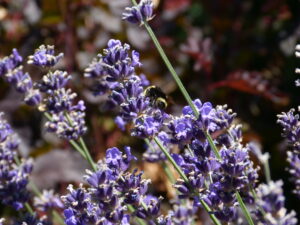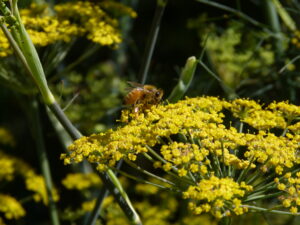
“She sat down in a weed patch, her elbows on her knees, and kept her eyes on the small mysterious world of the ground. In the shade and sun of grass blade forests, small living things had their metropolis.”
— Nancy Price
With the lush growth in our vegetable gardens comes the influx of garden creatures looking for their next meal, breeding ground and shelter for pupating. When we create our food gardens we are also creating habitat for all manner of insect life in the garden. This is an indisputable fact of garden ecology, and whether or not we have healthy and productive ecosystem depends on us, the garden managers. Being a responsible steward means that we are using sustainable practices.
But what does it mean to be a sustainable gardener when confronted with chewing or sucking herbivorous insects eating your dinner? Does it mean turning to the product shelf and applying that certified organic spray guaranteed to kill the culprits of our marred cabbage heads?
Gardeners must realize that certified organic products will also harm beneficial insect life in the garden. In areas where ponds and creeks are present, these products can also be harmful to amphibious and aquatic life. Though useful with extremely pestiferous cases, they are often oil-, soap- or plant-based and unselective to which insect they kill. Even Bacillus thuringiensis, selective to Lepidoptera, is not going to just kill pesky larvae but rather all moth and butterfly larvae! So instead of instinctively reaching for over-the-counter sprays, take a more holistic approach and spend time creating habitat for our insect allies, including the carnivorous, parasitic and, most importantly, pollinating insects to ensure the health of our gardens.
When thinking of habitat, one often imagines wild spaces, forests and alpine meadows where native fauna roam free. In a garden setting, the native fauna to which we refer are the beneficial insects that eat plant pests and pollinate our fruiting plants. Envision the garden as an exotic jungle full of productive flowering plants and forest litter made of garden mulch. Provide the right habitat and the beneficials will find our gardens. Soon our garden will be host to syrphid flies, predaceous ground beetles, lacewings, lady beetles and parasitic wasps conducting their lives and business in our gardens.



There are three major plant families that make our gardens more attractive to beneficial insects. First up is the mint family, or Lamiaceae, a no brainer for the vegetable gardener. It includes almost all of the Mediterranean herbs such as lavender, oregano, thyme, rosemary and mint as well as some flowering perennials like Monarda and Agastache. The flowers in this family are so attractive to winged insects that on any given summer day, when the lavender is in full bloom, we are able to walk up to a plant and see it vibrating with the multiple species foraging on the flowers.
The Carrot family, Apiaceae, is also a big part of the predatory insect palette. It boasts such notable plants as parsley, fennel, dill, lovage, angelica and cilantro. Perennials like Eryngium and Astrantia are also in this family. These plants have showy umbrella-shaped flowers at the tops of their stems. Some members of this family, like poison hemlock, are highly poisonous, while others like common fennel and Queen Anne’s lace are considered noxious weeds by the weed board of King County, so be sure to know your plants before placing them in the garden. Sure, if you are interested in herbs for culinary use, by all means harvest before they bloom, just be sure to have some reserved for insect use only. Some plants reward us for allowing them to flower; a patch of cilantro that goes to seed begets coriander seeds!
Last, but by no means least, is the large daisy family, or Asteraceae, whose members cheer up our gardens and provide many medicinal plants for us. These include Echinacea, chamomile, Rudbeckia, sunflower, Eupatorium, Calendula and many common garden flowers like marigold, zinnia and cosmos. Looking at this impressive list of colorful, fragrant and useful plants, we can see that including these in a garden setting is not a difficult task at all. In fact we probably already have many of them in the garden already!
How else can we steward the garden ecosystem? When placing these plant hosts in our gardens, make sure that they are not delegated to a distinct bed, but rather are integrated throughout the vegetable garden. This creates a habitat that encourages insects to visit the riotous bloom of lavender and then go on to the Blue Hubbard squash flower or gaggle of black bean aphids next. Yum.
When it comes to finding plants for insect habitat, many nurseries hold fall sales where you can load up. Fall is an optimal time to plant anyway, as seasonal rain provides moisture for your new plants and warm soil allows them to establish strong, deep root systems.
To learn more about which plants attracts which beneficials, visit Farmer Fred’s website: www.farmerfred.com/plants_that_attract_benefi.html. Or access our resource sheet Attract Benefical Insects.